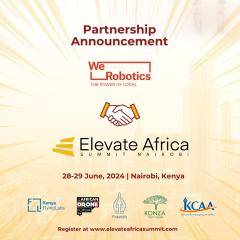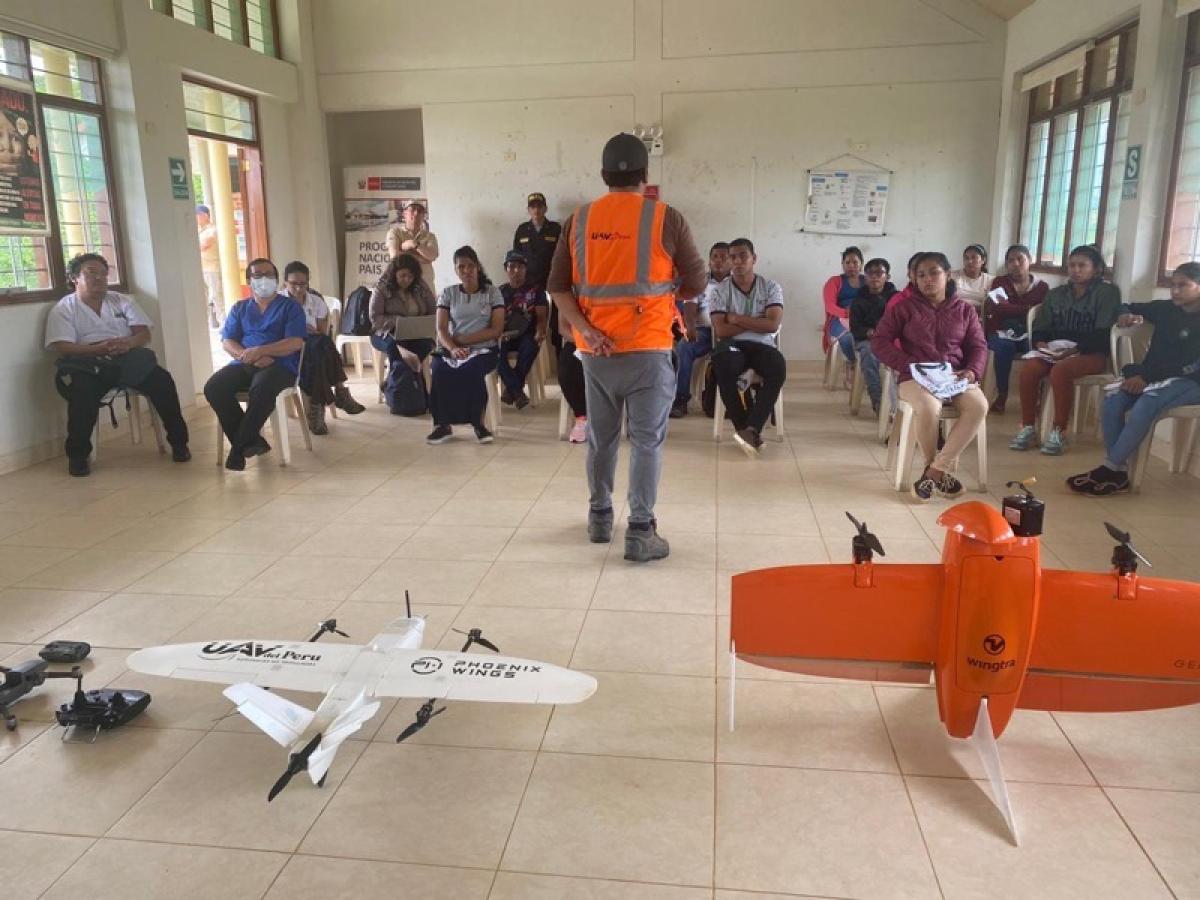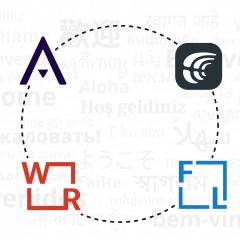
Building a Sustainable Ecosystem: Collaborative Growth in Peru's Drone Industry
December 6th, 2023

In the ever-evolving world of drone technology, gaining insights from professionals actively immersed in the industry is paramount to understanding its current state and potential for growth. Local experts serve as the pulse of innovation, offering unique perspectives and a window into how the industry has transformed over the years.
In this conversation, WeRobotics speaks with Kimberly Rojas, program coordinator of Peru Flying Labs. Kimberly is an aeronautical engineering student, drone pilot, and aviation enthusiast. She has worked with Unmanned Aerial Systems since 2017 with UAV Latam Peru company, which hosts Peru Flying Labs. As a Peru Flying Labs member, she has participated in several projects in humanitarian aid, medicine delivery with UAVs, natural disaster control, and recognition of vulnerable areas.
Our discussion delves into the drone ecosystem in Peru as it is today. We explore how the industry has grown, the remarkable work being done by Peru Flying Labs, and the critical role of collaboration in building a sustainable drone technology ecosystem in Peru and the Global South.
What was your first experience with drones? What drew you to this field?
I've always liked and enjoyed things related to aerospace. That's why I decided to study aerospace engineering here in Peru. At the beginning of my major, I had some lectures about UAVs and drones, how they are developed, and how they are used. The professors mostly talked about the big ones that the armed forces operate, and sometimes, they spoke of UAV design competitions for students. I joined a project for one of these contests in my second semester. That made me realize that people were dedicated to that field here in Peru. I learned a lot from this, and immediately after that, I had the opportunity to start an internship at UAV Latam Peru, which hosts Peru Flying Labs. Here, I began to understand how the drone industry is developing and all the applications of drones.
How different is the industry between then and now?
I have been in this field for six years and am always surprised by how much can change in one year. You could be studying something; the following year, it's completely obsolete. When I started, only maybe three companies were dedicated to the drone industry, but now, many people are investing in it. Private companies and the government are looking to develop projects using drones. Witnessing all this development through these years has been a really amazing experience for me.
It's really interesting that you mentioned that many more stakeholders are involved. That's essentially what we're trying to explore with this blog series because there are so many different stakeholders: NGOs, private companies, governments, and educational institutions. And fostering that kind of collaboration will help the Flying Labs achieve even more – if you want to go fast, go alone; if you want to go far, go together. So, we've focused on building an ecosystem instead of trying to do big things alone.
Yes, definitely. And it's great when you work with another company or educational institution because you all learn from each other and give so many good ideas to develop and do something more significant and bigger.
Could you describe some examples of Peru Flying Labs collaborating with another company, organization, or institution for an even greater social impact?
Peru Flying Labs did a Cargo Drone Delivery project in 2016 and 2017, and we have been trying to do something similar since. We collaborated with another NGO called CEDRO in 2022 and did a demo, which opened the door for us to jointly apply for funding to carry out a massive project in the jungle here. The jungle is the country's biggest area and the least populated. It's very difficult to reach some areas to transport medicines such as antidotes and ARVs to those living there. Many areas can only be reached by river, which is too slow, or by manned aircraft, which is too expensive. In such situations, using drones becomes the best alternative. As our previous Cargo Drone Delivery project was quite successful, we are looking forward to carrying it out again in collaboration with CEDRO for an even greater impact. We also hope to train local pilots in those areas to execute these operations themselves and not depend on us and other drone companies in the cities.
Another thing I'll mention is the value of the connections we make within the Flying Labs Network and how we learn from other Flying Labs. We previously did a STEM program but did not know how to plan and conduct it effectively. We just found ourselves in an environment with kids and thought, hey, let's teach them. But now we have a better approach thanks to last year's Flying Labs retreat. It helped me a lot to hear about the experiences that other Flying Labs had with their STEM projects and programs. We learned from them and recreated our own, and we remain committed to developing and running STEM programs for the youth and children.
We also partner with a university that shares our interest in developing STEM programs. I learned from Panama Flying Labs because they train university students. I liked their model because when you prepare students, your team can continue focusing on other projects. The impact is also bigger because you are not only teaching these children or young people in remote areas, but you're also training a group of university students, opening avenues for them, and encouraging them to develop their own projects and pursue their ideas. This fosters innovation and equips them to go out and do even more. So we implemented that here, and it has been a big success.

I love that you bring out the point that collaboration with universities does not mean just at the institutional level; it also means working with the students individually. It creates wins for you, the university, students, and children participating in your STEM programs. That's the power of collaboration. Do you structure the training for the university students like an internship program?
Yes. We asked the university for volunteers. The students sign up, prepare, and receive the training. We trained 10 university students to conduct the first edition of the STEM program and then asked them to return for the second edition. We retrained them, refreshed their knowledge, and equipped them to get even more out of this initiative than they did the first time.
That's such a great example of the value of collaboration. It's great that we're discussing the value of collaboration within the Flying Labs Network. You've mentioned learning from Panama Flying Labs, for example. Do you think international collaborations and networks of this kind will be essential for the growth of the drone industry in general and specifically in Peru?
Collaborations are always important. And if you establish contact with people from your region, not only your country, it gets really interesting. You find so many similarities. For example, last year, during the retreat, Bolivia Flying Labs talked about the forest fires in Bolivia and how they use drones to combat this challenge. Forest fires are not so common in Peru, but they mentioned that the ashes from their forest fires spread across the entire continent and cause damage to the whole Amazon. I didn't know that, and if I had not interacted with Bolivia Flying Labs, I might have never discovered that their problem is also ours. This is why the Network matters and why it is important to interact and collaborate with colleagues in different countries. It's really important to listen and learn from one another. It allows us to grow and makes our impact so much bigger.
What you've said about finding out that a problem you didn't even know of actually affects you is so interesting. I think that's a really useful thing to consider for every region because if you're facing similar problems, you can approach the problem from various angles and find complementary solutions.
Moving along, we'd like to hear more from you about the drone ecosystem in Peru. For an ecosystem, there are certainly other players: your business competitors, who can also be, in some cases, your collaborators. Are there ways that you're working with other drone companies or other drone professionals to nurture a thriving ecosystem?
Many companies provide services with drones, sell drones, or provide drone training. The ecosystem is huge. One thing we are doing now as a company is that we created an association for drone companies. And I think so far, there are four or five members. One of the objectives of doing this is to work together to address all the regulatory problems in the country. Because if one of us goes to the civil aviation authority and says, "Hey, I have this problem with this thing," they won't listen. If we approach them as a unit, they will pay attention and address the necessary changes. So, this association is meant to present ideas and proposals that will have a bigger impact.
We have also done many projects with other drone companies. For example, years ago, we had the opportunity to work with the Air Force here in the jungle to combat illegal mining. This is a huge problem because they use mercury to clean the gold for their process and then throw it into the rivers. This pollution causes a lot of damage to the environment and the people living there. We worked with another drone company, which was beneficial because we learned from each other. We learned how they manage their operations, expectations, and experiences in other projects.
That's wonderful to hear. Thank you so much for your time and for sharing your expertise, Kimberly. This has been really informative and insightful.
Over the years, the landscape of drone technology has shifted dramatically, with government initiatives, private companies, and educational institutions all playing significant roles. It is clear that collaboration remains the cornerstone of progress, and the remarkable work being done by the Flying Labs in the Global South is a testament to this.
Next, we fly to East Africa to speak with Tanzania Flying Labs. Stay tuned!
Recent Articles

